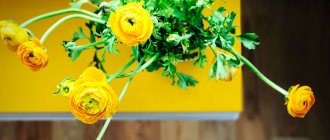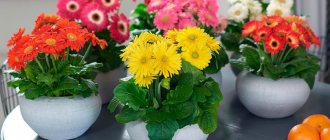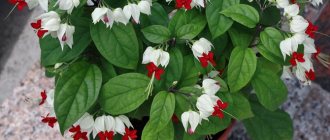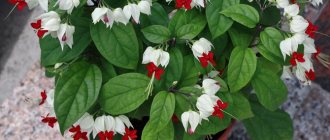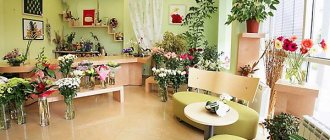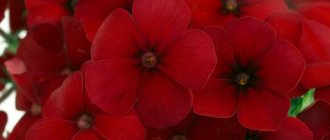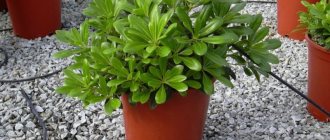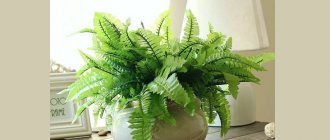What is special about these flowers?
Yellow houseplants have a variety of lovers. And this is no coincidence, because these flowers have a number of advantages over others:
- bright and sunny colors make the atmosphere of the house solemn;
- improve the well-being and cheer up the owners;
- Most of these plants not only have bright flower colors, but also beautiful leaves.
In addition to the listed benefits, yellow flowers have all the properties of other indoor plants. They humidify the air, saturate it with oxygen, protect against electromagnetic radiation and some viruses.
Blooming species with photos and names
Pay attention to a number of examples of unpretentious indoor plants with yellow flowers that even a novice gardener can handle. In response, they will certainly delight you with beautiful flowering:
Maple abutilone. This plant belongs to the mallow family and has maple-like leaves. It is characterized by brightly colored bell-shaped flowers, including yellow ones. The main thing it needs is regular watering. If this condition is met, abutilon can bloom until late autumn, and sometimes in winter.
Pachistachis yellow. It is an evergreen shrub up to 1 m tall with large dark green leaves. Its beautiful appearance is achieved not due to the flowers - they are white and rather inconspicuous, but thanks to the bright and unusual yellow bracts. They are the ones who maintain the decorative appearance of the Pakistani for several months
.
Common primrose. Several hundred plant species belong to the primrose genus. One of the most popular is the common primrose, which can grow both in open ground and in an apartment. It does not require complex care and grows well even with inexperienced gardeners. Blooming in early spring, the primrose is considered a primrose, and its bright yellow flowers symbolize the sun and the awakening of nature
.
Kalanchoe. Flowering begins at the end of winter and lasts about a month. The flowers come in yellow, white, red or purple umbels. In addition to its attractive appearance, Kalanchoe has a number of medicinal properties. Disinfects, stops bleeding, relieves inflammation and heals wounds
Yellow terry begonia. The love of flower growers is deserved by the ease of care and incredible beauty of lemon-yellow flowers, similar to roses and with a pleasant aroma. Florists often use it to decorate weddings and other events. Flowering continues for a long time, under favorable conditions, from May to early November. Begonia grows equally well in pots on the windowsill and in hanging pots or boxes on the balcony
Peculiarities! The popular name for begonia is a flower that purifies the air. Excellent removal of toxic compounds and dust.
Indoor yellow flowers are beautiful and varied. They look great both individually and in combination with flowers of other shades. Each gardener can choose a plant according to his taste.
Yellow chrysanthemums
They bloom in the cold season. These fluffy chicken-like creatures will bring warmth and joy to your home.
The feeling of joy will intensify if you place vases with chrysanthemums (or vases with bouquets) in opposite corners of the room, and place mirrors behind them.
Achimenes
A beautiful plant with bright green velvety leaves with smooth, neat teeth along the edges and soft yellow flowers.
Clivia
Beautiful flowers on which large inflorescences open - umbrellas consisting of 15 or more flowers of golden or fiery orange color.
They look fresh against the background of large dark emerald leaves collected in a rosette. Clivia, blooming luxuriantly in the cold season, brings warmth and joy to the house.
Abutilone or indoor maple
A very interesting and unusual plant with 5-petaled cup-shaped flowers hanging from top to bottom. By the way, they are not only yellow, but also orange, purple and bright red. Abutilon blooms almost until winter, and if you do not reduce the intensity of watering and install additional lighting, it will continue to please the eye even in winter.
it was called maple for its characteristic carved leaves, reminiscent of the leaves of the tree of the same name.
Clivia
A plant with a very unusual structure. Below, the long, fleshy leaves of a dense green color form a rosette from which a single thick stem grows. Its top is crowned by a spherical inflorescence, collected from 10-20 funnel-shaped flowers, reminiscent of Krasodnev flowers. This plant stands out effectively against the background of the rest of the home flora.
Clivia loves light, but does not tolerate direct rays and does not like heat. The optimal temperature for this is + 22… 25 ° C in summer and + 14 ° C in winter.
Pachistachis
Another unusual beauty, easily recognizable by its dark yellow candles. They stand out well thanks to their large oblong dark green leaves.
Pachistachis is another lover of low temperatures. It is best to live in an apartment away from radiators, in some corner that receives diffused sunlight. Moderate watering is desirable, the water needs to be settled.
If you want to feed your “pet,” use fertilizer for flowering indoor plants, which can be purchased at any flower shop.
Calathea saffron
If you see a plant with oval leaves, dark green on the front and purple on the scaly side, from which star-shaped candle-shaped flowers “peek out” tightly on straight, strong stems, know that you are looking at a calathea saffron. This is one of the most favorite flowers among amateur gardeners, as it has a bright appearance, but is not fussy to care for. It can also be placed in a corner where sunlight does not penetrate.
Justice is shadow
Also called Jacobinia, it blooms all year round, producing "fountains" of large golden inflorescences. The flowering is long and very abundant, and justice does not require more attention.
Guzmania
Exotic evergreen plant. The malachite-colored leaves are collected in a root rosette, from the center of which an unusual yellow flower grows on a high peduncle.
Bauhinia
The second name is orchid. This domestic tree grows up to 100 cm. The leaves of Bauhinia are oval-green, the flowers are bright lemon with a black dot inside.
Cattleya
Ligulate bright green elongated leaves beautifully highlight the golden flowers, reminiscent of large daffodils with a yellow-orange tubular perianth. Cattleya can bloom in spring, summer, and autumn.
Description of indoor plants with yellow flowers
The list of indoor plants with yellow flowers is extensive. It contains crops that are known even to people far from floriculture. For example, flowers such as begonia, primrose and daffodil.
In addition, this list includes less popular, but equally beautiful flowers:
- Calceolaria. A perennial herbaceous indoor plant with buds of unusual shape, similar to shoes. It is not surprising that the name translated from Latin means “little shoe”. The plant is characterized by abundant and long-lasting flowering, and the flower itself is so beautiful during this period that it is often given as a gift instead of a holiday bouquet.
- Aphelandra. Perennial shrub up to 1.5 m high from the Acanthaceae family. Its variegated leaves with a geometric pattern look beautiful and unusual even on their own, without flowering. Flowers of a yellow or golden hue, similar to cones, make the appearance of aphelandra even more exotic.
- Gerbera Jameson, or Transvaal daisy. It is a herbaceous perennial with chamomile-like inflorescences of various shades, including orange and golden yellow. Gerbera requires quite complex care, but if you follow all the rules, it will delight its owners with flowering almost all year round.
Home flowers with yellow jasmine flowers (JASMINUM)
Most jasmine are vines with fragrant buds and house flowers with yellow flowers. All of them require support for the stem and a cool room in winter. The easiest plant to grow is Jasminum polyanthum, which has pink buds and white flowers. J officinale has white, fragrant flowers, while J primulinum has yellow, odorless flowers.
Diversity
Polyanthus jasmine (Jasminum polyanthum) blooms in spring on 2.5 m long climbing stems. J officinale blooms in summer and early autumn. Primrose G (J primulinum) blooms in spring; its stems do not curl.
Care
Temperature: Moderate - minimum 7°C in winter.
St: Bright light with some direct sunlight.
Irrigation: Always keep the soil moist.
Humidity: Mist foliage frequently.
Replanting: If necessary, replant in spring.
Reproduction: in spring by cuttings. Use rooting hormones.
Acanthocalycium
This is the name of a cactus with a spherical shape. These yellow-flowered indoor flowers come in about twelve varieties. Depending on this, the flowers have different shades. The older the cactus, the longer its stem with fifteen or twenty ribs.
The spines are small, with different shades: yellow, brown, white. The flowers are very beautiful, but small in size. Acanthocalycium is distinguished by the presence of scales on the tube. This cactus can be found in many homes and offices.
Miniature succulents and cacti
There are small succulents in nature. These species, which grow in harsh, arid desert environments, have adapted to avoid wasting resources. Some store water in their leaves, others, like cacti, in thick trunks, and others are so small that they need very little moisture. Many of these plants are now grown indoors.
Lithops or living stones are truly amazing creatures. Their aerial part consists of thick and fleshy leaves, divided in two. A luxurious flower emerges from the center, which can be, depending on the species, white, red, yellow or hot pink. Lithops are extremely exotic: few plants can compete with them in originality. These succulents really look like round colorful stones, and some of them look like sea animals or corals.
Like other representatives of desert flora, lithops are very unpretentious: they do not need frequent watering and feeding, and are able to survive even in poor soils in the open sun. In addition, living stones are very miniature: no more than 5 cm in height and diameter. Lithops look unusually beautiful in compositions made from vases, with the inclusion of decorative crushed stone, shells and other succulents.
Gibbeum is very similar to lithopus. This is not surprising because the plants belong to the same family as Aizoceae. The appearance of gibbeum is very original: thick, fleshy leaves, split into two parts, form dense thickets on the soil surface. Exotic flowers are a bit like chrysanthemums and are painted in a variety of shades: soft pink, cream, lilac, orange. For its unusual appearance, this desert inhabitant was popularly nicknamed “baby cube”, “parrot beak” and “ostrich paws”.
The secrets of caring for gibbeum are simple: minimal watering, poor soil, as much sun as possible. Don't forget that the succulent stores water with the help of a long root, so the pot must be deep enough.
Lithops, gibbeum
Conophytum is another close relative of living stones. This is a miniature succulent with thickened heart-shaped or spherical leaves, the size of which does not exceed 1 cm; there are also varieties several mm high. The flowers of this exotic plant are also small and have bright, rich colors. Every year the conophytum grows very slightly, expanding mainly only in width.
In nature, the plant can only be found in South Africa, but in indoor culture conophytum is very popular. The shape of the small succulent is so unusual that it always pleases gardeners.
Faucaria, like the previous species, is a representative of the Aizov family. However, this plant is a little different from others. Faucaria can be recognized by its pointed and fleshy leaves, the edges of which are covered with soft, pubescent spines. Despite their extremely threatening appearance, these thorns only scare away animals and insects without causing them any harm. The leaves are collected in a dense basal rosette, the height of which does not exceed 10-15 cm; a yellow or white flower with thin needle-like petals blooms from the center of the rosette.
caring for faucaria, like other desert flora, is quite simple: the flower only needs infrequent watering, hot and dry air and poor soil.
Conophytum, faucaria
Rebutia is the name of a whole genus of miniature cacti, consisting of 20 species. These cacti are distinguished by their small height (up to 10 cm), a large number of pointed and spiny leaves, and bright and showy flowers. The stem is usually spherical, less often elongated, irregular in shape, juicy and dense.
In the house, if you follow simple care rules, rebutia grows well and blooms often. This dwarf cactus will not take up much space in the apartment.
Sulcorebutia, according to some sources, belongs to the genus Rebutia and, according to others, is a separate genus from the cactus family. Be that as it may, Sulcorebutia can be classified as a smaller cactus. The size of the plant does not exceed 5-10 cm. Despite the small stature of the tropical host, the chrysanthemum-like flowers are quite large and brightly colored.
Rebutia, sulcorebutia
Echinopsis or lobivia is a name that combines different types of cacti native to South America. Echinopsis are very diverse: round, elongated, with long or short spines. And the flowers of these cacti are very diverse: the petals can be red, pale pink, white or yellow. Usually domestic lobivias are of medium size, but there are several species, the height of which does not exceed 10-12 cm, for example, the spider echinopsis spinosa, Tigel, Yayoyan, Bakerberg and some others.
Thanks to its spectacular appearance and docile nature, this cactus has won the recognition of flower growers around the world and is now perhaps the most common home succulent.
Turbinicarpus is one of the smallest cacti. In nature, this plant is hardly noticeable among the vast deserts, but in small rooms it looks quite appropriate. Interestingly, due to its small size, the nasal shell was discovered only half a century ago, and scientists are still finding new species. The cactus has a large fleshy stem, divided into large segments, the tops of which are equipped with soft spines. Turbinicarpus, like many of its peers, has very showy flowers: large and bright, with long and thin petals.
Echinopsis, turbinate
These are adorable babies that can live in your home. Like all creatures of nature, they are very beautiful and will not take up much space on the windowsill. Expand your color collections and share your miniature finds in the comments.
↑ Yellow annual flowers
Shrub with yellow flowers, blooms in spring: photo, name
Flowers that are planted for one season are called annuals. They are grown by sowing seeds or planting seedlings. Annual flowers perfectly complement perennials in flower beds. The plants are not difficult to care for, they are almost not susceptible to diseases. Yellow annuals stand out in particular.
Marigold
Annual flowers with beautiful double caps. They grow in sunny areas and love moisture. The seeds germinate very quickly. They bloom until frost. Unpretentious plants, care for marigold plantings is minimal.
Petunia yellow
An unpretentious, profusely flowering plant that decorates flower beds until frost. Propagated by self-sowing, seedlings and seeds. The site needs a sunny side and regular watering.
Antirrinum Yellow
The name is overseas, but we better know the plant as snapdragon. Its original flower shape, and even yellow in color, will decorate a flower bed from June to September. Planted in well-lit places. For normal development and flowering, the soil needs to be well fertilized and drained. Regular watering is important.
Viola annual
These are the familiar pansies to all of us! Growing them is not difficult, they are unpretentious to care. They grow well in sunny areas. Feeding and watering are important in care. Frequent guests at rock gardens, flower beds and ridges.
Gaillardia
The yellow-red flower is often planted in a separate group, which decorates unsightly corners of the garden. You can place gaillardia as in this photo:
We recommend studying: names and descriptions of the best unpretentious long-blooming perennial flowers for the garden
It blooms almost all summer. In terms of care, fertilizing during flowering and watering are important.
Gazania yellow
Gatsania is also called African chamomile. The yellow petals open only at midday. The plant will decorate any garden. Planted both in sunny places and in partial shade.
Helichrysum
Everyone knows these flowers as a plant called immortelle. Flowering is always abundant, starting in May and continuing until October. Cut flowers stay fresh for a very long time; florists use this quality. Low-growing varieties decorate paths.
Calendula
Low-growing and medium-growing varieties of calendula have been developed. Flowering begins in June and continues until October. An unpretentious plant, without special requirements for the gardener. Calendula is used as a medicinal plant.
Cosmidium
An annual plant with showy small flowers. Not only the flowers are beautiful, but also the delicate leaves. It begins to bloom from July until frost. For normal development and flowering, fertilized and drained soil is needed.
Eschscholzia californica
Without transplanting to a new location, they are grown for up to 7 years. Yellow-orange bushes look beautiful in group plantings. Eschscholzia blooms in July, the flowering is abundant, but short-lived, only two weeks.
Ranunculus
This yellow flower is also known as the garden buttercup. A beautiful, double inflorescence blooms up to 9 cm in diameter. An adult bush grows up to 60 cm. Planted in shady places. Buttercup is a lover of marshy soils and needs regular watering.
How to decorate a flower garden in yellow tones?
When creating a sunny flowerbed, select flowers with different flowering periods. Then the flowerbed will always be blooming. Plants can be planted in a flower garden in a row or in a circle, or in the shape of a square or diamond. It all depends on your imagination.
Photos of flower beds decorated with yellow flowers:
We recommend studying: unique low-growing annual flowers for the garden that you have not seen
Benefits of miniature plants
Passionate collectors and gardeners often collect a huge number of flora in their homes. The only thing that can serve as a limitation to the constant expansion of personal collections is the size of the room.
Unfortunately, not everyone can boast of even average apartments. Generally the area is small. Purchasing large flowers in such living conditions is not very reasonable or convenient.
But, on the other hand, this is not a reason to deprive yourself and your loved ones of positive emotions from home gardening. Agree: the variety and richness of forms created by nature really has no boundaries.
It makes sense to turn your attention to miniature indoor plants. They are practically no different, except for the size of large indoor plants. But at the same time, the space required to place them will be much less.
There are plenty of miniature species, and most of them are designed for growing in apartment conditions. Some types of such flowers are the work of nature itself, others are the result of the good work of a large number of experienced breeders.
In any case, among the many different varieties and species, everyone will be able to choose a flower to their taste: it blooms beautifully and brightly, it is pleasant for its decorative effect and abundantly developed foliage system, it is juicy, and so on.
How to make it bloom?
By providing complex and painstaking care for the plant, every gardener hopes that they will delight it with bright, long flowering. Usually, if the rules are followed, flowers such as aphelandra and calceolaria do not have problems blooming.
As for Jameson's gerbera, the absence of peduncles can be caused by a number of other reasons:
- a voluminous pot and, as a result, the strength of the flower goes to the development of roots;
- pan too narrow;
- nitrogenous soil;
- water and sprinkle with ice water.
Eliminating these factors helps achieve flowering of a particular crop.
Attention! Constant flowering of gerbera leads to a shortening of its lifespan. It is necessary to periodically arrange a lull for the flower.
Difficulties in home care
Indoor plants with red flowers
Plants with yellow flowers vary greatly in both appearance and growing habits. Some of them, such as primrose, begonia, jacobinia and glottiphyllum tongue-shaped, are unpretentious and do not require complex care. Even gardeners without much experience can grow them. Others, such as Jameson's gerbera, calceolaria and aphelandra, require special growing conditions and a lot of attention.
Caring for Jameson's gerbera involves:
- regular watering;
- feeding;
- annual transplants;
- periodically inspect the flower for pests.
For favorable growth, gerberas require a significant amount of sunlight, but without direct sunlight. In the summer, it is placed on a balcony (preferably glazed), because... Gerbera does not tolerate sudden changes in day and night temperatures. It is necessary to water the crop at least 2 times a week, more often in the hot season. Water for irrigation should not be cold. Every two weeks during the period of growth and flowering, the gerbera is fed with complex fertilizer.
The main thing in caring for calceolaria is constant high air humidity. To achieve this, young plants are covered with a cap and a container of water is placed nearby. Water the flower often, but little by little, with water at room temperature. Excess water from the pan is immediately poured out.
Calceolaria requires sufficient sunlight during the day, at least 8 hours. On cloudy days and in winter, artificial lighting is used to illuminate the flower.
Important! Calceolaria is contraindicated in direct sunlight, because they are the cause of burns and spots on the leaves.. The basic principles of caring for aphelandra are systematic feeding, maintaining high humidity in the room, sufficient lighting and a temperature of at least 16 degrees
Aphelandra is a plant native to the tropics, so it is important to bring its indoor conditions closer to natural ones.
The basic principles of caring for aphelandra are systematic feeding, maintaining high humidity in the room, sufficient lighting and a temperature of at least 16 degrees.
Aphelandra is a plant native to the tropics, so it is important to bring its indoor conditions closer to natural ones.
A little more about the benefits of house plants
Indoor plants will make the air cleaner.
Many seemingly mundane houseplants have the magical ability to suppress pathogenic bacteria. Almost all microbes and bacteria in the immediate vicinity are killed by phytoncides secreted by asparagus, ficus, pelargoniums, conifers, and monstera.
Houseplants can also remove phenol and formaldehyde from indoor air. These harmful substances can be released from new furniture. And even small amounts of benzene, ammonia and carbon monoxide can be neutralized by plants.
Indoor plants will improve your mood.
It has been scientifically proven that when a person looks at a plant, he becomes calmer and more peaceful. During scientific experiments, it was found that in the company of domestic or wild plants, a person’s emotional background increases and various vital indicators improve.
Indoor plants protect our health.
Indoor plants significantly improve the indoor microclimate. They increase humidity and reduce dust. Many doctors have noted this interesting fact: patients placed in plant rooms recover faster and generally feel better.
Indoor plants will increase your productivity.
Note to Employers: Are you looking to improve your employees' productivity? Place some indoor plants in your work area. It has been proven that plants improve the mood and emotional background in the team, and therefore the productivity of each employee.
Maple abutilone
This indoor plant can delight with its flowering until late autumn. Its flowering fades as daylight hours shorten. In winter, the flower enters a dormant period and stops blooming. But if you continue to water regularly and install additional lighting lamps, the maple will not stop blooming in winter.
An indoor flower with yellow flowers, whose name is abutilon, has an interesting feature. The leaves of the indoor tree are similar to maple leaves. Hence the name. It is very easy to care for the flower: observe the frequency of watering and watch the growth. If you don’t like the shape of the flower, pinch off the excess shoots. That's all. Abutilone is a natural or hybrid plant. The latest varieties are distinguished by more diverse shapes and shades of flowers.
How to water and fertilize?
Any home culture needs a sufficient amount of moisture. When watering, you must follow some rules:
- It is important to moisten the soil in a timely manner. Most indoor plants like the soil to be constantly moist;
- the amount of liquid increases during the period of active growth and flowering. This usually occurs in spring and summer;
- on particularly hot days, you should not only water the plant, but also water its above-ground parts. It is best to use a spray bottle for these purposes;
- water for irrigation should be at room temperature (for exotic plants from hot countries, you can warm it up a little);
- Some species do not like direct contact of liquid with the roots, so they should be watered very carefully.
Carefully! Excessive moisture is just as harmful to the plant as its lack, so do not over-moisten the soil. Otherwise, there is a danger of soil acidification, root rot and fungal development.
Feeding and fertilizers are usually carried out during the growing season, in the spring. In some cases, additional fertilizers are necessary, for example if the soil is not suitable for growing. This procedure is best carried out in early autumn.
Clivia
These yellow indoor flowers are often found in the collections of gardeners who love plants for their interesting structure. The dark green leaves form a lush rosette, which emphasizes the amazing beauty of the inflorescence. It contains from ten to twenty lush flowers of a yellow or orange hue.
Clivia is a light-loving plant. But she does not like direct sunlight and high indoor temperatures. For comfortable growth, twenty-two to twenty-five degrees of heat in the summer is enough. During winter dormancy, the flower should be placed in a room with a temperature of fourteen degrees above zero.
Yellow flowers in the home interior
There are many signs associated with flowers. Everyone knows that an even number of colors is not given. Some flowers (bastard and zamioculcas) bring good luck and prosperity to the house; others give happiness in their personal lives (hippeastrum, stephanotis, jasmine).
Dear men are given gladioli and carnations, young girls are given delicate white lilies of the valley and pink alstroemeria, and beloved women are given red roses.
For some reason, it is generally accepted that yellow flowers bring bad luck. They do not want to give or receive them with fear; they try not to keep them at home. In contrast, yellow flowers are popular in Japan. They are considered gifts from the sun.
It is believed that a person, giving yellow tulips or roses, wishes health and happiness. According to the beliefs of different peoples, yellow flowers bring wealth and financial success to the house, protect the house from diseases and evil people.
In our country, since time immemorial, they have been a symbol of everything negative: separation, sadness and jealousy.
Johann Wolfgang von Goethe, a famous German poet and great thinker, wrote a treatise “On the Theory of Colors” at the beginning of the 19th century, in which he called the brilliant yellow color “magnificent and noble.
Plain yellow, according to Goethe, is characterized by “cheerfulness and soft beauty.” But you need to be careful with this color, look carefully at its shades - dirty yellow is considered a symbol of disgust and terrible shame.
